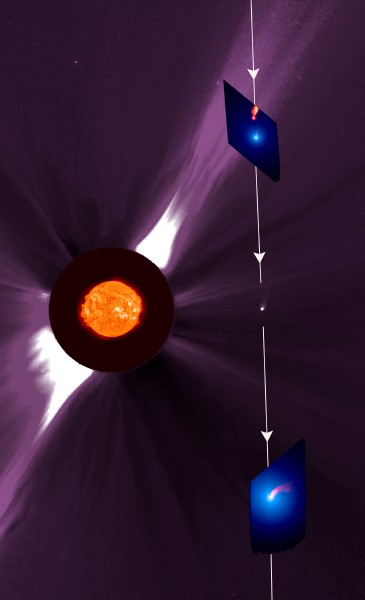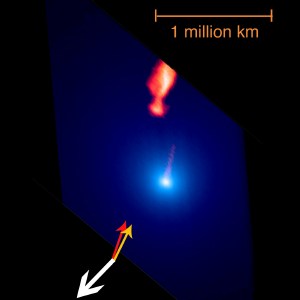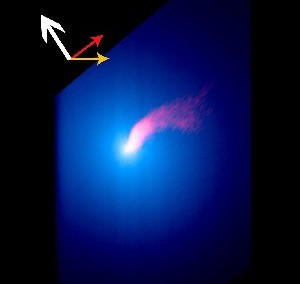Kudo-Fujikawa Revisited
Click on images for larger versions
|
|
The composite image (above, left) gives a SOHO's-eye view of Comet C/2002 X5 (Kudo-Fujikawa) as it passed within 0.2 AU of the Sun in late January 2003. The path of the comet is drawn in white, with arrows indicating the direction of the orbital motion. The solar disk is shown as an EIT image in He II line at 304 A. The background is a combination of LASCO C2 and C3 images of the corona in visible light, and the blank annulus around the Sun represents the occulting disk of the C2 camera. The LASCO image also reveals the comet in the optical, visible as the fuzzy white dot to the right of the Sun.
The UVCS images of the comet in the ultraviolet are far more dramatic. Shown to scale and in the proper positions relative to the Sun on the sky in the composite, these two images (upper right and lower right) depict the comet in the H I Lyman alpha 1216 A line (blue) and the C III 977 A line (red-orange). The nucleus of the comet is located at the brightest point in Lyman alpha, at the center of a quasi-spherical cloud of hydrogen gas that is the size of the Sun. The Lyman alpha emission also shows the brightening of the comet as it passes through perihelion, reflecting a fivefold increase in the comet's production of water.
The C III emission has never before been observed in a comet. Here it reveals the plasma tail, which appears strongly foreshortened because the comet is essentially on the far side of the Sun from Earth and SOHO, and hence the tail, pointed away from the Sun, also points away from us. In the first UVCS image, the main plasma tail has disconnected from the nucleus of the comet and is drifting antisunward even as a new, dim plasma tail is born from the nucleus. By the time the second UVCS image was taken, the new plasma tail has become quite bright and is beginning to turn as the comet prepares to leave the vicinity of the Sun. The unexpected brightness of this tail is due to a production rate of carbon ions that is at least 25% of the mean water production rate over the 30-hour duration of these observations. Such a high rate of carbon production implies that organic compounds in the cometary dust are being sublimated in order to supply carbon ions to the plasma tail. This depletion of the dust tail may help to explain Comet Kudo-Fujikawa's decidedly unimpressive appearance in the LASCO images.
Related links
- Suns Of All Ages Possess Comets, Maybe Planets
(Harvard-Smithsonian Center for Astrophysics press release)- Doubly Ionized Carbon Observed in the Plasma Tail of Comet Kudo-Fujikawa
(Science Magazine)- SOHO Observes Comet
(SOHO Pick of the Week - 27 January 2003) - Doubly Ionized Carbon Observed in the Plasma Tail of Comet Kudo-Fujikawa
Picture credits: SOHO/UVCS, SOHO/LASCO, SOHO/EIT (ESA & NASA)
Instruments: UVCS (Ultraviolet Coronagraph
Spectrometer), LASCO (Large Angle Spectroscopic Coronagraph), EIT
(Extreme Ultraviolet Imaging Telescope)
Taken: 27-29 January 2003





